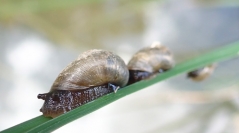

 Zoosystema
43 (19) - Pages 365-376
Zoosystema
43 (19) - Pages 365-376Within the Succineidae Beck, 1837, the shape and size of the shells, as well as the coloration of the animal bodies, make it difficult to identify the different species on this basis alone. This is particularly the case for Oxyloma elegans (Risso, 1826) and Oxyloma sarsii (Esmark, 1886), whose taxonomy has barely stabilised. Indeed, different names have been used alternately for these two species, thus creating confusion about the delimitation and knowledge of the taxa actually involved. The relevant diagnostic characters used to distinguish them are based on morpho-anatomical characters that can only be accessed by dissection. On the occasion of the discovery of Oxyloma sarsii in north-eastern France (Alsace and Franche-Comté), we illustrate the characters that should be used for its identification, characters that are rarely illustrated in the dedicated literature. Oxyloma sarsii is easily distinguished from other species by the insertion of the bursa copulatrix canal on the distal part of the vagina, which is also very elongated and characteristically S-shaped. Furthermore, we show that the shell dimensions and habitats usually given in the identification guides for this species only partially cover the observed variability within and among populations. We show here that the shell height can range from at least 7.1 to 17.4 mm, whereas the literature considers the range to be 10 to 15 mm, exceptionally 20 mm. We therefore recommend a systematic examination of the characters provided here not only for Oxyloma sarsii, but also for O. elegans and Succinea putris (Linnaeus, 1758), two species often found in the same habitats.
anatomy, diagnostic characters, Oxyloma elegans, Succinea putris, Bas-Rhin, Jura